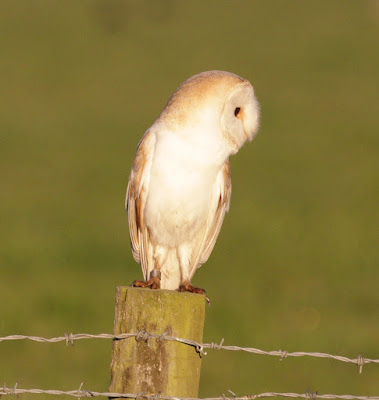It was on December 2018 in Another Bird Blog, that I related the latest chapter in the chronicle of Project Linnet with Linnet AJD5167, caught on 18 September on the Scottish island of North Ronaldsay, Orkney, 605 km due north of Gulf Lane. We had recaptured the Linnet at Gulf Lane on 24th December 2018. This was a clear example of autumnal juvenile dispersal/migration to a wintering destination.
And now we have another Linnet that evidences the link between our locally wintering Linnets with Northern Scotland and the Northern Isles.
This latest one is a fine example of a first year wintering bird returning in the following spring to the same area in which it was born. AJD6518 was caught and ringed at Gulf Lane, Cockerham as a juvenile male 26th November 2018 and recaptured at the North Ronaldsay Bird Observatory, Orkney Isles on 07th May 2019. This is a time of year when the Linnet had either finished or was very close to the end of its spring migration, a journey of 605 km from Lancashire.
This latest one is a fine example of a first year wintering bird returning in the following spring to the same area in which it was born. AJD6518 was caught and ringed at Gulf Lane, Cockerham as a juvenile male 26th November 2018 and recaptured at the North Ronaldsay Bird Observatory, Orkney Isles on 07th May 2019. This is a time of year when the Linnet had either finished or was very close to the end of its spring migration, a journey of 605 km from Lancashire.
Linnet- Cockerham to Orkney
AJD6518 was one of only two Linnets captured on the day of 26th November during a period when the Linnets were proving very hard to trap. This result and others vindicate mine and Andy’s efforts at that time to continue with the project despite some very low catches with very cold and frustrating mornings when the Linnets would not cooperate.
The capture of AJD6518 with a wing measurement of 87 mm was one of several Linnets from the 650+ plus captured as part of the project over three winters that triggered “possible error” messages on DemOn, the BTO online database where ringers enter their captures.
"Possible Error" - BTO DemOn
As in previous captures/recaptures we have noted that these movements of Scottish birds involve slightly darker plumaged birds and those with slightly longer wings. In many species of birds a tendency to have longer wings than other individuals can be a pointer to clinal variation or sometimes a different sub species. Clinal definition - "a gradual change in a character or feature across the distributional range of a species or population, usually correlated with an environmental or geographic transition."
"Scottish" Linnet
At the present time our Project is on target to recommence in August/September 2019 and into spring 2020. Farmer Richard has sown the crop of bird seed mix, the spring and summer so far has been good for growth and we expect a healthy crop will lead to a good number of autumn and winter Linnets to ring, many of them from Scotland.
Results like these highlight the value and importance of agri-environment schemes that are designed to benefit farmland birds. In this case a wintering population of many hundreds of Linnets that use the small Gulf Lane site throughout the winter months, enabling them to survive, migrate in the spring and to then breed in order to maintain their population.
And finally, a reminder from The Common Bird Census and Breeding Bird Survey of the population trend of the Linnet and the reason for our project.
Back soon.
In the meantime, linking to https://paying-ready-attention-gallery.blogspot.com and http://id-rather-b-birdin.blogspot.com. Take a look.
And finally, a reminder from The Common Bird Census and Breeding Bird Survey of the population trend of the Linnet and the reason for our project.
Linnet - 1966- 2017 via BTO
Back soon.
In the meantime, linking to https://paying-ready-attention-gallery.blogspot.com and http://id-rather-b-birdin.blogspot.com. Take a look.






















































































